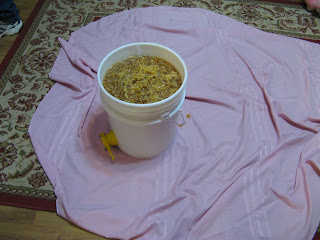
I'd always known that Russ wanted a dog. I like dogs and years ago it seemed like a good idea. More recently I had decided I wasn't interested in the additional mess and responsibility of a dog, not with two toddlers to care for. I came up with the perfect compromise - we'll get a cat! In my imagination, getting a cat was going to be great. We would feed it and it would take care of itself, occasionally letting us pet it.
I was still under the impression that the cat was the right option when I arrived at my sister-in-law's for Thanksgiving. She has two cats and we have spent lots of time there before, but I had previously failed to see exactly how much her cats hate my children. I realised that we would have to find an exceptionally patient cat to live in our house and that would be tricky. It might end up hating my children anyway. Toddlers are not cat people. A dog would be a better fit for our family.
I hadn't yet told Russ of my change of mind. A week ago, he mentioned that he'd been on PetFinder and had seen an adorable pug-poodle cross. I surprised him when I suggested that we go and see it. We made some tentative plans to see the dog, but Russ found out that it was being spayed and not ready for visitors.
On Saturday morning, we wanted to look at puppies and ended up at the local pet shelter. We were only there to look. The shelter didn't have any dogs there that were right for us, but the guy mentioned that they had a cocker spaniel at an adoption event in town that might meet our needs. We had a free morning, so we headed over to the adoption event. There were lots of adorable black lab puppies, some older dogs and then we found Homer. He was just the right size - a medium-sized cocker spaniel with a beautiful cream/golden coat. I could tell that Russ was immediately taken with him. We took Homer for a little walk with the girls, who both had to hold the leash. We were having a hard time deciding if we should wait to see if the pug-poodle would eventually be available to us or possibly get Homer, when I did something unusual for me and made the bold decision to take the dog home. We filled out some forms and Homer was ours.
The first 24 hours were a little overwhelming. Homer was very excited and also had some diarrhoea. Our second day with him has been much better. Russ and I have been on a number of walks with him and he is calm now. He's doing really well with the girls, though I think he was somewhat confused when Alex and Rosie tried to feed him imaginary food this morning. He'll get used to it. We're glad to have him.






























